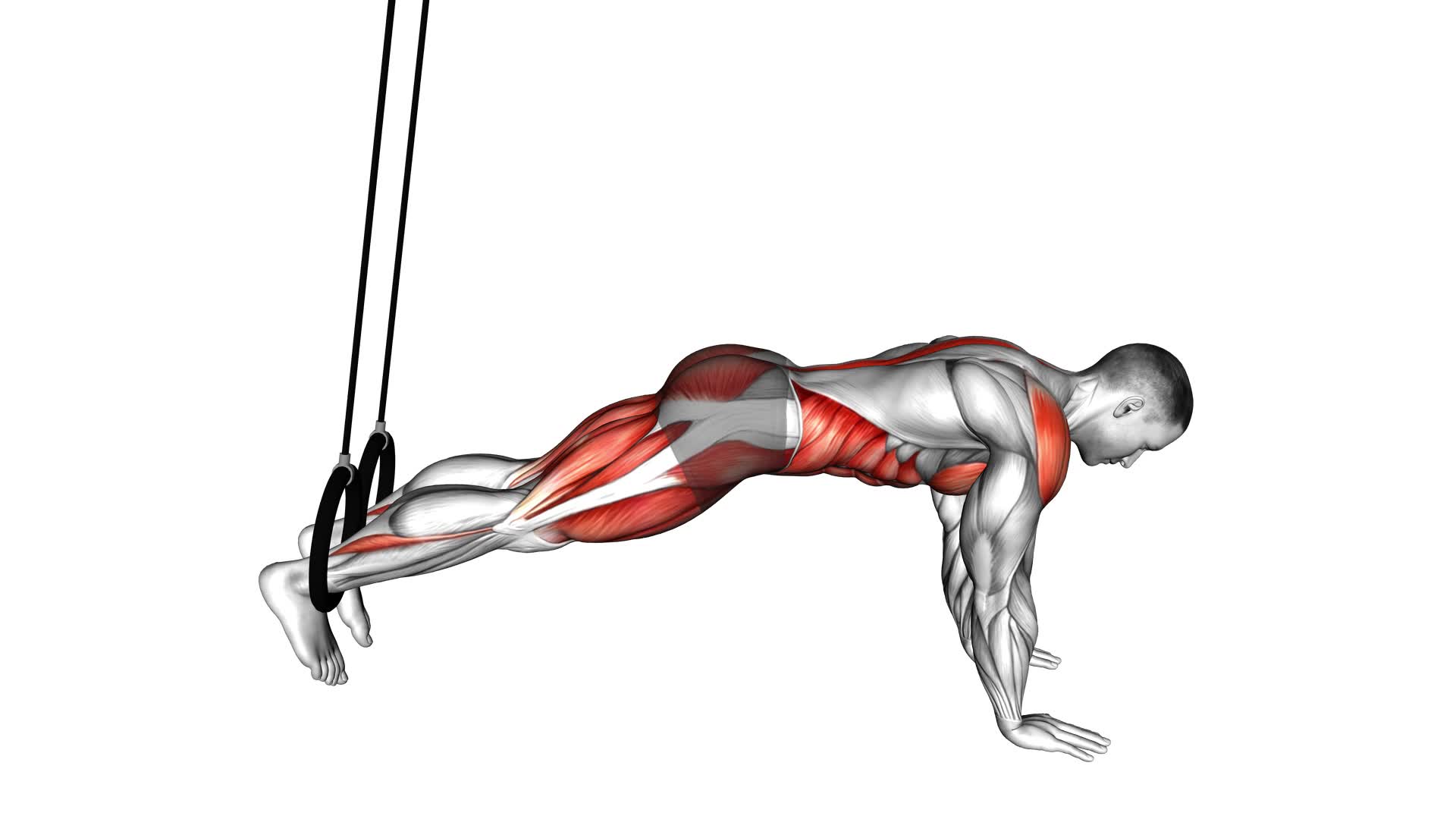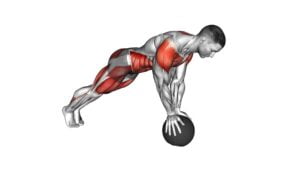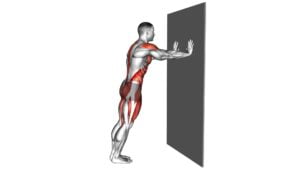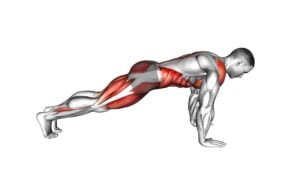Ring Mountain Climber (male) – Video Exercise Guide & Tips

Are you ready to take your mountain climbing game to the next level? The Ring Mountain Climber is here to challenge and strengthen your entire body.
Watch This Exercise Video
In this video exercise guide, you'll learn the proper form and technique to get the most out of this dynamic movement. Whether you're a beginner or an advanced climber, we've got modifications to suit your skill level.
Get ready to conquer new heights and maximize your results with the Ring Mountain Climber. Let's go!
Key Takeaways
- The Ring Mountain Climber provides an effective and challenging full-body workout.
- Proper form and technique are essential to target multiple muscle groups and improve cardiovascular endurance.
- Modifications are available for both beginners and advanced users to gradually increase intensity.
- Common mistakes to avoid include sagging hips, overloading the exercise, and improper form.
Benefits of the Ring Mountain Climber
To maximize your results and strengthen your core muscles, the Ring Mountain Climber provides an effective and challenging workout for you. This exercise is a compound movement that targets multiple muscle groups simultaneously, making it a great addition to your workout routine. By incorporating the Ring Mountain Climber into your workouts, you can maximize your results and take your fitness to the next level.
The Ring Mountain Climber is a dynamic exercise that engages your core, shoulders, arms, and legs. It requires coordination, stability, and strength, making it a complete workout for your entire body. As you perform the exercise, your core muscles are constantly engaged to maintain stability and control. This not only strengthens your core, but also improves your balance and posture.
In addition to targeting your core muscles, the Ring Mountain Climber also works your shoulders, arms, and legs. As you bring your knees towards your chest, you engage your upper body, specifically your shoulders and arms. Meanwhile, your legs are actively involved in the movement, providing an intense workout for your lower body.
Incorporating the Ring Mountain Climber into your workout routine is a great way to add variety and challenge to your training. Whether you're a beginner or an advanced fitness enthusiast, this exercise can be modified to suit your fitness level. So, start incorporating the Ring Mountain Climber into your workouts and watch as your results skyrocket!
Proper Form and Technique
Maintain proper form and technique while performing the Ring Mountain Climber to ensure maximum effectiveness and prevent injury. To help you visualize the correct form, imagine yourself in a push-up position with your hands placed on the ground shoulder-width apart. Now, picture your feet resting on a pair of rings suspended from the ceiling.
Here are some important tips to maintain proper form and technique during the Ring Mountain Climber:
- Keep your core engaged and your body in a straight line from head to toe.
- Maintain a steady and controlled pace as you alternate bringing your knees towards your chest, simulating a climbing motion.
- Imagine you're scaling a steep mountain, with every knee drive propelling you higher.
- Visualize the muscles in your arms, shoulders, and core working together to stabilize your body as you climb.
Proper form and technique are crucial for reaping the benefits of the Ring Mountain Climber. By performing the exercise correctly, you target multiple muscle groups simultaneously, including your arms, shoulders, core, and legs. This exercise also improves your cardiovascular endurance and helps burn calories, making it an effective addition to any workout routine.
Modifications for Beginners and Advanced Users
Explore different modifications to adapt the Ring Mountain Climber exercise based on your fitness level and goals. Whether you're a beginner looking to build strength or an advanced user seeking a more challenging workout, there are modifications available to suit your needs.
For beginners, it's important to start with proper form and gradually increase intensity. To modify the Ring Mountain Climber, you can begin by performing the exercise on an elevated surface, such as a bench or step. This reduces the amount of weight on your arms and shoulders, making it easier to maintain balance and stability. Additionally, you can slow down the pace of the exercise and focus on controlled movements. This allows you to build strength and endurance gradually while maintaining proper form.
Advanced users can modify the Ring Mountain Climber to make the exercise more challenging. One option is to add a twist to the movement by bringing your knee towards the opposite elbow, engaging your oblique muscles. You can also increase the speed and intensity of the exercise, performing the movement at a faster pace or adding a plyometric element, such as jumping between each rep. These modifications will help to further improve cardiovascular fitness and enhance overall strength and coordination.
Common Mistakes to Avoid
When performing the ring mountain climber exercise, it's important to pay attention to your form and technique to avoid common mistakes.
One common mistake to avoid is improper form, such as sagging your hips or rounding your back.
Another mistake to watch out for is overloading the exercise by going too fast or not maintaining control.
Form and Technique Errors
To achieve optimal results, focus on mastering proper form and technique while performing the ring mountain climber exercise. It's important to be aware of common misconceptions and take necessary precautions for injury prevention.
Here are some form and technique errors you should avoid:
- Arching the back: Keep your core engaged and maintain a neutral spine throughout the exercise. Arching the back can strain the lower back and lead to discomfort or injury.
- Allowing the hips to sag: Keep your hips level with your shoulders and avoid dropping them towards the ground. This ensures proper alignment and engages the core effectively.
By avoiding these form and technique errors, you can maximize the benefits of the ring mountain climber exercise and minimize the risk of injury.
Now, let's move on to the next section about overloading or improper form.
Overloading or Improper Form
Avoid overloading or using improper form while performing the ring mountain climber exercise to prevent injuries and ensure optimal results.
Overloading your muscles by adding too much weight or performing too many repetitions can lead to strains, sprains, or even tears. It's important to listen to your body and gradually increase the intensity of the exercise over time.
Additionally, using proper form is crucial to prevent injuries. Maintain a straight back, engage your core, and ensure that your knees are aligned with your hips and ankles. Improper form can put unnecessary stress on your joints and muscles, increasing the risk of injury.
How to Incorporate the Ring Mountain Climber Into Your Workout Routine
Are you ready to take your workout routine to the next level? Incorporating the Ring Mountain Climber into your workouts can provide you with a multitude of benefits.
Not only does it target your core and upper body, but it also improves your cardiovascular endurance.
Whether you're a beginner or an advanced athlete, there are variations of this exercise that can be tailored to your fitness level.
Benefits of Ring Climbers
Incorporating ring climbers into your workout routine can provide numerous benefits. Here are some reasons why you should consider adding this exercise to your regimen:
- Improved core strength: Ring climbers engage your core muscles as you stabilize your body, helping to strengthen your abs, lower back, and obliques.
- Increased upper body strength: By performing ring climbers, you work your chest, shoulders, and arms, including your biceps, triceps, and forearms.
- Ring mountain climber modifications: You can modify this exercise by elevating your feet or adding a twist to further challenge your muscles.
- Advanced variations: Once you have mastered the basic ring climber, you can try more advanced variations such as the single-arm ring climber or the ring climber with a knee tuck to intensify the workout and target specific muscle groups.
Incorporating ring climbers into your routine not only helps build strength but also enhances overall stability and flexibility. So, grab those rings and start climbing towards your fitness goals!
Variations for All Levels
To incorporate the ring mountain climber into your workout routine, try these variations suitable for all fitness levels.
For beginners, start by performing the exercise on your knees instead of in a full plank position. This reduces the intensity and allows you to focus on proper form and stability.
As you gain strength and confidence, progress to the traditional ring mountain climber, where you alternate bringing your knees towards your chest while maintaining a strong plank position.
For advanced modifications, you can increase the speed of the movement, add a push-up between each knee drive, or even try performing the exercise on a single arm. These variations challenge your coordination, core strength, and overall fitness level.
Remember to always listen to your body and choose a variation that suits your current abilities while still providing a challenge. Keep pushing yourself and enjoy the benefits of the ring mountain climber in your workout routine.
Proper Form and Technique
To properly incorporate the ring mountain climber into your workout routine, focus on maintaining a strong plank position while alternating bringing your knees towards your chest. Here's how you can achieve proper form and technique:
- Start by getting into a plank position with your hands on the rings and your body in a straight line.
- Engage your core muscles by tightening your abs and glutes.
- Keep your shoulders stacked over your wrists and your hips level throughout the exercise.
Begin the movement by bringing one knee towards your chest, while keeping the other leg extended. As you bring your knee in, exhale and squeeze your abs. Return the leg back to the starting position and repeat with the opposite leg. Continue alternating legs in a controlled and rhythmic manner.
Tips for Maximizing Your Results
Get the most out of your workouts by implementing these tips to maximize your results.
To achieve optimal results, it's crucial to focus on effective workout techniques.
Firstly, make sure to set specific goals for yourself. Having a clear objective will help you stay motivated and track your progress.
Additionally, varying your workouts is key. Incorporating different exercises and training methods not only keeps your routine interesting but also prevents your body from hitting a plateau.
Remember to prioritize intensity over duration. Short, high-intensity workouts can be more effective than long, low-intensity ones.
To further maximize your results, pay attention to your nutrition. Fueling your body with the right nutrients before and after workouts can enhance your performance and aid in muscle recovery.
Lastly, don't forget to rest and recover. Your body needs time to repair and rebuild after intense workouts. Incorporate rest days into your schedule to prevent overtraining and promote optimal results.
Frequently Asked Questions
How Many Calories Can I Burn by Doing the Ring Mountain Climber Exercise?
Doing the ring mountain climber exercise can help you burn a significant amount of calories. By engaging your core, upper body, and lower body, this exercise is a great full-body workout. The number of calories you burn will depend on factors such as your weight, intensity, and duration of the exercise.
To properly perform the ring mountain climber exercise, start in a push-up position with your hands on the rings, then alternate bringing your knees towards your chest. Try different variations to challenge yourself and keep your workouts interesting.
Is the Ring Mountain Climber Suitable for People With Knee or Back Problems?
Yes, the ring mountain climber exercise can be suitable for people with knee or back problems. This exercise helps strengthen the core muscles and improve overall stability.
However, it's important to consult with a healthcare professional or a qualified fitness trainer before incorporating this exercise into your routine. They can provide personalized modifications and guidance to ensure that you perform the exercise safely and effectively.
Can the Ring Mountain Climber Help Me Build Upper Body Strength as Well?
Yes, the ring mountain climber can definitely help you build upper body strength. By incorporating variations and modifications of the exercise, you can target different muscle groups in your upper body, such as your arms, shoulders, and chest.
The ring mountain climber engages your core muscles as well, providing a full-body workout. Push yourself to try different ring mountain climber variations to challenge your upper body strength and achieve your fitness goals.
What Other Exercises Can I Combine With the Ring Mountain Climber for a Full-Body Workout?
To get a full-body workout, try combining the ring mountain climber with other exercises. By incorporating variations of the ring mountain climber, you can target different muscle groups and increase the intensity of your workout.
Additionally, including other ring exercises like ring dips, ring rows, and ring push-ups can further enhance your upper body strength and core stability.
This combination will help you build a strong and balanced physique. Keep pushing yourself and enjoy the benefits of incorporating ring exercises into your routine!
Are There Any Specific Breathing Techniques I Should Follow While Performing the Ring Mountain Climber?
When performing the ring mountain climber, it's important to focus on your breathing technique. Proper breathing can help you maintain control and maximize the benefits of the exercise.
Take a deep breath in as you bring your knees towards your chest, then exhale forcefully as you extend your legs back. This will engage your core muscles and provide stability.
Remember, beginners can modify the intensity by slowing down the movement and taking shorter breaks between repetitions.
Keep pushing yourself!
Conclusion
Incorporating the Ring Mountain Climber into your workout routine can provide a multitude of benefits. This exercise can improve core strength, increase cardiovascular endurance, and enhance overall body coordination. Both beginners and advanced users can perform this exercise effectively by following proper form and technique. It is important to avoid common mistakes and make modifications when necessary to ensure optimal results. So, challenge yourself and maximize your fitness journey by adding the Ring Mountain Climber to your exercise routine today!

Author
Years ago, the spark of my life’s passion ignited in my mind the moment I stepped into the local gym for the first time. The inaugural bead of perspiration, the initial endeavor, the very first surge of endorphins, and a sense of pride that washed over me post-workout marked the beginning of my deep-seated interest in strength sports, fitness, and sports nutrition. This very curiosity blossomed rapidly into a profound fascination, propelling me to earn a Master’s degree in Physical Education from the Academy of Physical Education in Krakow, followed by a Sports Manager diploma from the Jagiellonian University. My journey of growth led me to gain more specialized qualifications, such as being a certified personal trainer with a focus on sports dietetics, a lifeguard, and an instructor for wellness and corrective gymnastics. Theoretical knowledge paired seamlessly with practical experience, reinforcing my belief that the transformation of individuals under my guidance was also a reflection of my personal growth. This belief holds true even today. Each day, I strive to push the boundaries and explore new realms. These realms gently elevate me to greater heights. The unique combination of passion for my field and the continuous quest for growth fuels my drive to break new ground.



